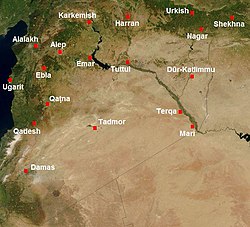
Zahiran also known as Sahiri or Sa-hi-ri, [1] also known as Zahiran [2] was an Iron Age city of the ancient Near East. [3] It was a city in what is today Syria.

Zahiran also known as Sahiri or Sa-hi-ri, [1] also known as Zahiran [2] was an Iron Age city of the ancient Near East. [3] It was a city in what is today Syria.
During the Mari–Ebla war (2300 BC) Zahiran was the site of a battle between Igrish-Halam King of Ebla, [4] [5] [6] [7] and Iblul-il, King of Mari. [8] [9] About a decade later, it would be absorbed into the empire of Sargon of Akkad.
The town was sacked in the Battle of Nineveh (612 BC). The chronicle of Aššur-uballit II, known as Chronicle 3, [10] states of the Battle of Nineveh between Babylonian and Assyrian armies that "in the month Âbu [ broken anchor ] the king of Akkad and his army went upstream to Mane, Sahiri and Bali-hu. He plundered them, sacked them extensively, and abducted their gods." [11] [12]